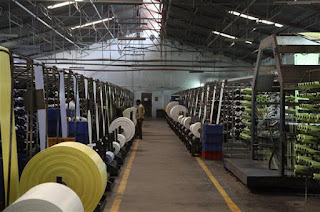DIE CLEANING TIPS
 ●Die cleaning is something few operators like to do. It’s hot. Your arms get tired. It’s not air-conditioned. There are a few things that can make the job easier. If available, try to use a fractional melt index LDPE to purge out with. It has been found that adding additional anti oxidant to the purge polymer before shutting down helps in removal of the polymer from the chrome surface of the die. Common coating grades of LDPE of 4 MI or higher are stickier than the fractional melt index resins, and continue to drip out of the parts left on the machine. After separating the die, use a mono and diglycerides to reduce the viscosity of the polyolefins to that of about water. You can almost wipe off the polymer with a cloth. Use it by melting the powder or flake form of mono and diglycerides and pouring it into a paper cup with a wooden tongue depressor as a handle. It is affectionately called a lollipop. Apply it on the poly left on the die at temperatures of 275°F(135°C) to 300°F(149°C). At this temperature it will readily melt. As always make certain to read and follow the suppliers MSDS. With some copper mesh you can remove most of the polymer with very little elbow grease. Finish by wiping down with cheesecloth. The mono and diglycerides will not help in the removal of polyamide or polyester.
●Die cleaning is something few operators like to do. It’s hot. Your arms get tired. It’s not air-conditioned. There are a few things that can make the job easier. If available, try to use a fractional melt index LDPE to purge out with. It has been found that adding additional anti oxidant to the purge polymer before shutting down helps in removal of the polymer from the chrome surface of the die. Common coating grades of LDPE of 4 MI or higher are stickier than the fractional melt index resins, and continue to drip out of the parts left on the machine. After separating the die, use a mono and diglycerides to reduce the viscosity of the polyolefins to that of about water. You can almost wipe off the polymer with a cloth. Use it by melting the powder or flake form of mono and diglycerides and pouring it into a paper cup with a wooden tongue depressor as a handle. It is affectionately called a lollipop. Apply it on the poly left on the die at temperatures of 275°F(135°C) to 300°F(149°C). At this temperature it will readily melt. As always make certain to read and follow the suppliers MSDS. With some copper mesh you can remove most of the polymer with very little elbow grease. Finish by wiping down with cheesecloth. The mono and diglycerides will not help in the removal of polyamide or polyester. Now what do you do about the carbon that built up on the die lips? It is easily removed with copper mesh and chrome polish. The die still needs to be hot (300 - 350°F /149 -177°C) for this to work without a lot of rubbing. You need to be careful with this step as the liquids in the chrome polish can flash through you glove and scald your hand. Wrap the copper mesh around several layers of cheesecloth or other soft cotton rag to add additional protection for your hand. Apply a small amount of chrome polish to the mesh and rub on small areas at a time. The chemicals in the chrome polish seem to react with the carbon and/or boil off the carbon. This technique seems to work on carbon deposits from polyamides, polyesters, and polyolefins.



Sir please send me godet roll ratio setting formula
ReplyDeleteSir, Plant runing time continue puncture( pin hole) found.
ReplyDeletePls suggest for this problem.
Starting main heat down krlia krain sheet me holes ana bnd ho jaingy ...
Deleteraw material burning issue please down the adapter and die temrature starting time.
DeleteIs filter alignment possible for film puncture?
DeleteIt is a given that that set of curtains nowadays are more affordable compared before. That is why most households opt to procure a new set of curtains. Instead of buying new curtains for the windows of our home, give them the care and cleaning it need. Cleaning the curtains is more practical. I will offer you useful curtain cleaning information and make them last better and longer.
ReplyDeleteSir me diner to tapet ka formula
ReplyDeleteKia question hay apka ... Smjh nhi aya
DeleteSir , length, width malum ho to Gpm kaise nikale
ReplyDeleteHow to calculate material in kg from take to percentage % with mixing?
ReplyDeletePlease say any one how much temperature range of annealing godet ?
ReplyDelete